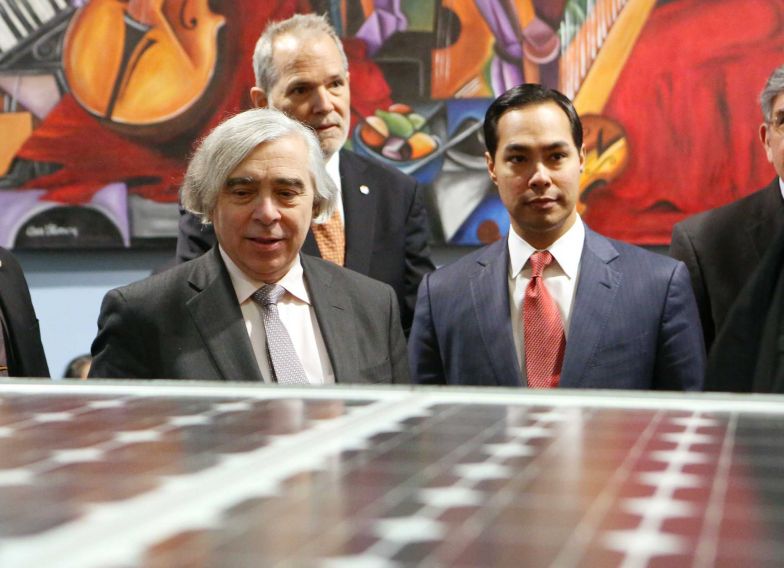Energy secretary backs mix of power sources

February 07, 2014 | posted by The Institute
Source: houstonchronicle.com
By: Vicki Vaughan

U.S. Energy Secretary Ernest Moniz, with San Antonio Mayor Julian Castro, spoke to high school students on Thursday about their solar car. Photo Credit: Helen L. Montoya, Staff
During a visit to San Antonio Thursday, Energy Secretary Ernest Moniz said President Barack Obama's push for use of all energy sources - his "all of the above" energy policy - is the best solution to meet the nation's power needs.
At the same time, he said it's a clear goal of the administration to reduce carbon emissions, which means building capacity for clean energy and fostering innovation. Costs for wind and solar are falling, he said, which is aiding the push for renewables. Energy efficiency, from more efficient lighting to appliances, also is playing a part.
Moniz stated the administration's case in a town hall meeting of students and community residents at the University of Texas at San Antonio's downtown campus, where he praised the city and the university for being leaders in clean energy and innovation.
Before the town hall talk, Moniz briefly looked over students' renewable- energy projects and stopped to ask questions of Madison High School students about a solar-powered car on display.
After his talk, Moniz declined to discuss the status of the proposed Keystone XL pipeline, saying it is a State Department matter.
He also demurred when asked whether it's a good idea to lift the nation's almost total ban on exporting oil, saying it's an issue for the Commerce Department to consider.
But Moniz didn't shy away from saying the administration's "holistic" energy strategy includes support of advances in nuclear-reactor construction. For example, the Energy Department is working to finalize a loan guarantee for the construction of two small modular nuclear reactors in Georgia, he said.
"Nuclear power plants have been getting bigger and bigger," he said, and the capital requirements are enormous. The plan in Georgia is to build smaller reactors, "which have very good safety characteristics" that would be less expensive, he said.
"The idea is that if you go small enough, you can build all of the guts of the plant in a factory, put it on a flatbed truck and take it to the site," Moniz said. "So you get the quality control in the factory environment and you get the stable workforce in the manufacturing environment."
The smaller reactor "sounds very promising, but we don't know until we do it," he said.
As for nuclear waste, Moniz said that Yucca Mountain, a proposed nuclear waste site in Nevada, "is not viable. There are very strong objections to it. It was not a consent-based process."
An independent commission has recommended that the nation have a "consent-based process that provides by far the better conditions for success," he said.
Another important step would be for Congress to authorize a pilot site where spent fuel could be stored.
The site would store spent fuel from reactors that have been shut down. It would be a site or sites "where there is no reactor - there is only spent fuel. That would be a sensible first step," Moniz said.
Moniz said that the nation's energy boom also is prompting an analysis of energy infrastructure that may be completed by year's end.
"If we need to draw down the Strategic Petroleum Reserve - and we move through pipelines or maritime - now we find that some of the pipelines have changed direction," he said. "So that's why we're looking comprehensively at the whole infrastructure."
The outcome of the analysis, he said, "will be a set of recommendations of what the federal government can do to help evolve the infrastructure in the right direction, so that it's smart and resilient for the 21st century."








